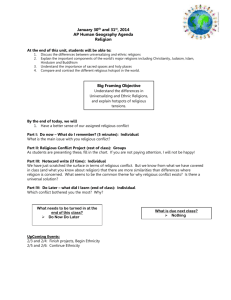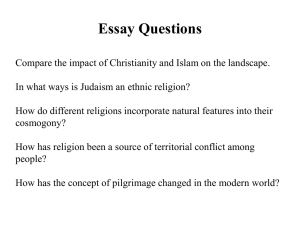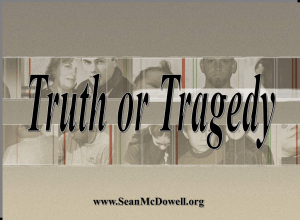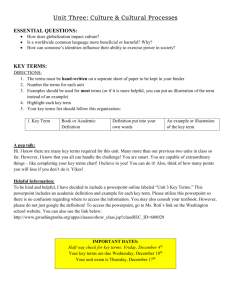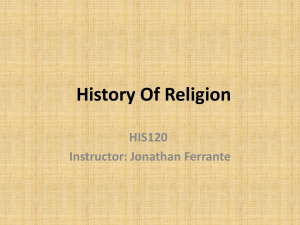Chapter 6 Learning Guide – Religion
advertisement
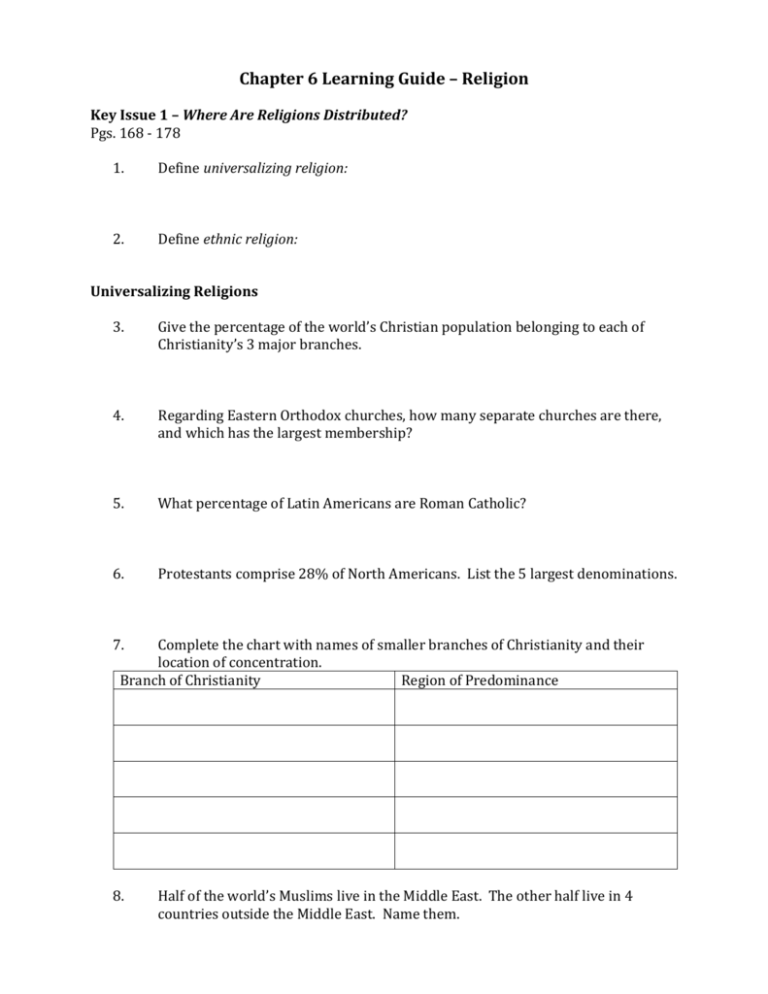
Chapter 6 Learning Guide – Religion Key Issue 1 – Where Are Religions Distributed? Pgs. 168 - 178 1. Define universalizing religion: 2. Define ethnic religion: Universalizing Religions 3. Give the percentage of the world’s Christian population belonging to each of Christianity’s 3 major branches. 4. Regarding Eastern Orthodox churches, how many separate churches are there, and which has the largest membership? 5. What percentage of Latin Americans are Roman Catholic? 6. Protestants comprise 28% of North Americans. List the 5 largest denominations. 7. Complete the chart with names of smaller branches of Christianity and their location of concentration. Branch of Christianity Region of Predominance 8. Half of the world’s Muslims live in the Middle East. The other half live in 4 countries outside the Middle East. Name them. 9. Give the percentage of each of Islam’s 2 greatest branches: Sunni & Shiite (Shia). 10. Only in 5 countries do Shiite Muslims number more than Sunni. What are they? 11. Buddhism is built around “Four Noble Truths” as taught by the Buddha. Summarize them. 12. Complete this chart dividing Buddhism into its 3 main branches. Branch % of Global Regions of Predominance Buddhist Population 13. Why are Buddhists difficult to count? Ethnic Religions 14. Where are Hindus concentrated? What percent of all Hindus live there? 15. Where are most of the rest? Make a note or two (that seem of geographic interest) about each of the following ethnic religion listed in #’s 16 – 20. 16. Confucianism: 17. Daoism: 18. Shintoism: 19. Judaism: 20. Animism: Chapter 6 Learning Guide – Religion Key Issue 2 – Why Do Religions Have Different Distributions? Pgs. 178 – 191 Origin of Religions 1. Complete the chart below describing the origins and branches of the major universalizing religions. Christianity Islam Buddhism Year of Origin Founder Major Branches & Main Belief of Each Branch Regarding Hinduism 2. How was its origin different than universalizing religions? 3. When did it originate? 4. Where did it originate? 5. What 2 ancient peoples beliefs blended to form Hinduism? Diffusion of Religions 6. Give 3 explanations for the diffusion of Christianity. 7. Give 3 ways in which Islam spread. 8. Give 2 reasons for the expansion of Buddhism. 9. Provide 3 examples of cases in which religions, or religious practices, have blended. Religions Which Have Blended Location Regarding Judaism 10. How is its distribution very different from other ethnic religions? 11. What was the diaspora? 12. How were most Jews treated as they lived among other nationalities? 13. What is the origin of the term ghetto? Holy Places 14. What is a pilgrimage? 15. Read the section Holy Places and make notes on 3 case studies: Buddhism, Islam & Hinduism. Holy Sites Buddhist Islamic Hindu The Calendar 16. Complete the chart below regarding religious calendars. What is the most prominent feature of the calendar in an ethnic religion? What is the principle purpose of the calendar in a universalizing religion? 17. How is the Jewish calendar typical of the ethnic use of the calendar? 18. What is the solstice? 19. Both the Jewish and the Muslims use a lunar calendar, yet in a different way and with very different results. Explain. 20. How is the date of Easter related to physical geography (the natural world) through the calendar? 21. Why do different Christian branches celebrate Easter on different days? 22. How is this similar to Buddhism’s major holidays? Chapter 6 Learning Guide – Religion Key Issue 3 – Why Do Religions Organize Space in Distinctive Patterns? Pgs. 191 – 195 1. In what 2 ways do religious structures often stand out in a landscape? Places of Worship 2. For what 2 reasons does a church, the physical structure, play a more critical role than in other religions? 3. Complete the following chart to express unique visible features of Christian churches. Christian Branch or Region Unique Design/Typical Feature Orthodox Christianity Protestant (esp. N. America) Northeast U.S. Southeast U.S. Southwest U.S. Latin America 4. How is a Muslim mosque viewed differently than a Christian church? 5. Identify 4 specific, visible features of a typical mosque. 6. How are Hindu temples different than both churches and mosques? 7. List 3 typical visible features of a Hindu temple. 8. What is the religious purpose of a Buddhist pagoda? 9. How was pilgrimage a part of the development of pagodas? 10. Formal worship in a pagoda is not typical. Where does it usually take place? Sacred Space 11. Christian practice burial of the dead. Complete the flow chart below to indicate the history of this practice. 12. Complete the chart below with brief notes on the disposal of the dead in ways other than burial. Hindus Parsis Micronesia 13. Complete the chart below with brief notes on the religious settlements indicated. Utopian Settlements Salt Lake City, Utah Puritans Administration of Space 14. Define hierarchical religion: 15. List the Roman Catholic hierarchy, indicating geographic region and leader who heads it. 16. Why are parishes in Latin America so much larger than in Europe? 17. Describe an autonomous religion: 18. In the absence of a hierarchy, what is the only formal organization of territory in Islam? 19. What holds Islam together? 20. Complete the chart below to categorize other religions and denominations. Autonomous Religions Hierarchical Religions Chapter 6 Learning Guide – Religion Key Issue 4 – Why Do Territorial Conflicts Arise Among Religious Groups? Pgs. 195 – 203 Religion Versus Government Policies 1. In what ways did the Taliban government of Afghanistan raise conflicts with Western/modern ideas after it took control of the country in 1996? 2. What aspect of Hinduism has clashed with Western/modern ideas? 3. What western groups criticized this aspect? Why? 4. How has the Indian government responded to this issue? 5. In Russia/Soviet Union, how did each of the following attempt to limit the influence of religion, specifically the Eastern Orthodox Church? Czar Peter the Great: Communism: 6. What happened, and is continuing to happen, in each of the following regions of the Russian Empire/Soviet Union since the fall of Communism in the 1990s? Complete the chart below by adding THREE more countries to each category and then describing what is going on at the present time in that region. Historic Catholic Regions Croatia, Czech Republic, Hungary, Lithuania, … Currently… Historic Muslim Regions Kazakhstan, Kyrgyzstan, … Currently… 7. How was the Vietnam War detrimental to Buddhism in Southeast Asia? 8. How were Communist regimes detrimental to Buddhism in Southeast Asia? Religion Versus Religion 9. Define fundamentalism: 10. Fundamentalism is increasing in the world today and its growth contributes to conflicts. Why is it increasing? 11. What are two religious groups in conflict in Ireland? 12. Where are the majority of these groups located? 13. What 3 religions are in constant conflict over the land in the Middle East? 14. What was the military campaign by the Christians to recapture their Holy Land from the Muslims? 15. Complete the chart below regarding the perspective on the Holy Land. Palestinian Perspective Israeli Perspective Chapter 6 Learning Guide – Religion Key Issue 1 – Where Are Religions Distributed? Pgs. 168 - 178 1. Define universalizing religion: Religion that attempts to appeal to all people, not just those living in a particular location. 2. Define ethnic religion: Religion that appeals primarily to one group of people living in one place. Universalizing Religions 3. Give the percentage of the world’s Christian population belonging to each of Christianity’s 3 major branches. Roman Catholic – 51%; Eastern Orthodox 11%; Protestant 24% 4. Regarding Eastern Orthodox churches, how many separate churches are there, and which has the largest membership? 14 self-governing churches; Russian Orthodox 5. What percentage of Latin Americans are Roman Catholic? 93% 6. Protestants comprise 28% of North Americans. List the 5 largest denominations. Baptist, Methodist, Pentecostal, Lutheran & Presbyterian 7. Complete the chart with names of smaller branches of Christianity and their location of concentration. Branch of Christianity Coptic Church of Egypt Ethiopian Church Armenian Church Maronites Church of Jesus Christ of Latter-Day Saints Region of Predominance N.E. Africa N.E. Africa Lebanon, Armenia, northeastern Turkey & western Azerbaijan Lebanon Utah & surrounding states 8. Half of the world’s Muslims live in the Middle East. The other half live in 4 countries outside the Middle East. Name them. Indonesia, Pakistan, Bangladesh & India 9. Give the percentage of each of Islam’s 2 greatest branches: Sunni & Shiite (Shia). Sunni 83% Shiite 16% 10. Only in 5 countries do Shiite Muslims number more than Sunni. What are they? Iran, Azerbaijan, Iraq, Oman & Bahrain 11. Buddhism is built around “Four Noble Truths” as taught by the Buddha. Summarize them. 1. All living beings must endure suffering; 2. Suffering leads to reincarnation; 3. Goal is to reach Nirvana through moral & mental self-purification; 4. Nirvana is achieved through Eightfold Path 12. Complete this chart dividing Buddhism into its 3 main branches. Branch Mahayana Theraveda % of Global Buddhist Population 56% 38% Tantrayana 6% Regions of Predominance China, Japan & Korea Cambodia, Laos, Myanmar, Thailand & Sri Lanka Tibet & Mongolia 13. Why are Buddhists difficult to count? Only a few people participate in Buddhist institutions; not a formal religious system Ethnic Religions 14. Where are Hindus concentrated? What percent of all Hindus live there? 97% of all Hindus live in India 15. Where are most of the rest? Nepal Make a note or two (that seem of geographic interest) about each of the following ethnic religion listed in #’s 16 – 20. 16. Confucianism: Ethnic religion begun by Confucius in Chinese province of Lu; teaches ethical principles of following tradition, fulfilling obligations & treating others with sympathy & respect. 17. Daoism: Begun by Lao-Zi & emphasizes mystical & magical aspects of life not importance of public service 18. Shintoism: Ethnic religion of Japan; was official state religion until end of WWII; political cult & religion; deceased became important deities 19. Judaism: 14 million Jews worldwide; most in U.S. & Israel; 2 main universalizing religions find their roots in Judaism (Islam & Christianity); began in Canaan; 1st religion to support monotheism 20. Animism: Belief that inanimate objects, plants & stones or natural events like earthquakes have spirits & conscious life; practiced by 100 million Africans but is declining due to universalizing religions Chapter 6 Learning Guide – Religion Key Issue 2 – Why Do Religions Have Different Distributions? Pgs. 178 – 191 Origin of Religions 1. Complete the chart below describing the origins and branches of the major universalizing religions. Year of Origin Founder Christianity 4 BC – 30 AD Jesus Major Branches & Catholicism Main Belief of Each God conveys his Branch grace to humanity via 7 sacraments Orthodox Accepts 7 sacraments but rejects Pope & doctrines Protestantism Salvation achieved thru direct communication with God & faith Islam 6th Century Muhammad Sunni Quran Shiite Quran **Disagreement over line of succession of Islamic leadership is major difference Regarding Hinduism 2. How was its origin different than universalizing religions? Didn’t originate with s a specific founder 3. When did it originate? 6th century B.C. 4. Where did it originate? India 5. What 2 ancient peoples beliefs blended to form Hinduism? Aryans & Dravidians Buddhism 5th Century BC Siddhartha Gautama Theravada To become good Buddhist one must renounce worldly goods & become a monk Mahayana Emphasize teaching, compassion & helping others Diffusion of Religions 6. Give 3 explanations for the diffusion of Christianity. 1. Relocation diffusion by missionaries from Palestine; 2. Contagious diffusion by daily contact between believers & non-believers; 3. Hierarchical diffusion thru acceptance by the emperor 7. Give 3 ways in which Islam spread. 1. Conquering land in Palestine, Persia & India; 2. Relocation diffusion by missionaries in Sub-Saharan Africa & S.E. Asia; 3. Arab traders in Indonesia 8. Give 2 reasons for the expansion of Buddhism. 1. Missionaries in Ceylon; 2. Merchant traders to China 9. Provide 3 examples of cases in which religions, or religious practices, have blended. Religions Which Have Blended Christianity & African religions Buddhism & Shintoism Hinduism, Islam & Christianity Location Equatorial Guinea, Namibia & other African countries Japan Island of Mauritius Regarding Judaism 10. How is its distribution very different from other ethnic religions? It’s practiced in many countries; not just place of origin 11. What was the diaspora? When Romans forced Jews out of the Mediterranean 12. How were most Jews treated as they lived among other nationalities? Many Jews were persecuted; forced to live segregated 13. What is the origin of the term ghetto? Neighborhood set up by law where Jews were required to live Holy Places 14. What is a pilgrimage? Journey for religious purposes to a place considered sacred 15. Read the section Holy Places and make notes on 3 case studies: Buddhism, Islam & Hinduism. Buddhist Islamic Hindu Holy Sites Important because they’re located where 8 particular events happened in Buddha’s life; Most located in northeastern India & southern Nepal; Lumbini is most important (Buddha’s birthplace) Makkah (Mecca) birth place of Muhammad; Ka’ba is religious shrine in center of Mecca housing black stone given to Muhammad by Gabriel; Median tomb of Muhammad; Every Muslim is expected to make hajj to Mecca Places of importance are rivers & coastlines; Tirtha (pilgrimage) are acts of purification; Shrines are established by tradition, not doctrine; Hindus believe Ganges River is for purification; Mt. Kailas important (Siva lives there) The Calendar 16. Complete the chart below regarding religious calendars. What is the most prominent feature of the calendar in an ethnic religion? Celebration of seasons – cycle of variation in climatic conditions for successful agriculture What is the principle purpose of the calendar in a universalizing religion? Commemorates events in founder’s life 17. How is the Jewish calendar typical of the ethnic use of the calendar? Holidays are based on agricultural events as well. 18. What is the solstice? Astronomical event that happens in June & December resulting in the longest & shortest days of the year. 19. Both the Jewish and the Muslims use a lunar calendar, yet in a different way and with very different results. Explain. Jews – calendar inserts extra month every few years so holidays fall at the same time; Islam – adheres to strict lunar calendar so holidays arrive at different seasons from generation to generation. 20. How is the date of Easter related to physical geography (the natural world) through the calendar? Relates to agricultural cycle as a joyous time of harvest in southern Europe; time of anxiety over planting new crops in northern Europe & N. America 21. Why do different Christian branches celebrate Easter on different days? Protestants & Catholics use Gregorian calendar while Orthodox use Julian calendar 22. How is this similar to Buddhism’s major holidays? Different Buddhists observe & celebrate events on different calendar days as well Chapter 6 Learning Guide – Religion Key Issue 3 – Why Do Religions Organize Space in Distinctive Patterns? Pgs. 191 – 195 1. In what 2 ways do religious structures often stand out in a landscape? Usually tallest & most elaborate building Places of Worship 2. For what 2 reasons does a church, the physical structure, play a more critical role than in other religions? It’s an expression of religious principles & created in the image of God 3. Complete the following chart to express unique visible features of Christian churches. Christian Branch or Region Orthodox Christianity Protestant (esp. N. America) Northeast U.S. Southeast U.S. Southwest U.S. Latin America Unique Design/Typical Feature Highly ornate topped with dome Simple with little ornamentation Built with wood Built with brick Adobe Stucco & stone 4. How is a Muslim mosque viewed differently than a Christian church? Viewed as a location for the community to gather; not sanctified 5. Identify 4 specific, visible features of a typical mosque. Central courtyard; pulpit facing Mecca; Cloister for school/activities; minaret tower to call people to worship 6. How are Hindu temples different than both churches and mosques? Built to house shrines for gods rather than for worship 7. List 3 typical visible features of a Hindu temple. Symbolic artifact (image of the god); structure for the caretaker; pool for ritual baths 8. What is the religious purpose of a Buddhist pagoda? House Buddha’s relics (portions of Buddha’s body or clothing) 9. How was pilgrimage a part of the development of pagodas? People traveled to other countries to build pagodas to house relics 10. Formal worship in a pagoda is not typical. Where does it usually take place? At adjacent temple, monastery or at home Sacred Space 11. Christian practice burial of the dead. Complete the flow chart below to indicate the history of this practice. Catacombs – in ancient Rome when Christianity was illegal Church Yards – when Christianity became legal Cemeteries – operated by public management beginning in 19th century 12. Complete the chart below with brief notes on the disposal of the dead in ways other than burial. Hindus Parsis Micronesia Use of cremation Exposure of dead to scavenging birds & animals Disposal of body at sea 13. Complete the chart below with brief notes on the religious settlements indicated. Utopian Settlements Salt Lake City, Utah Puritans Ideal community built around a religious way of life Established by Mormons with church related buildings at strategic points New England settlers that placed church in center of the settlement next to public open space called a common Administration of Space 14. Define hierarchical religion: Has well defined geographic structure & organizes territory into local administrative units. 15. List the Roman Catholic hierarchy, indicating geographic region and leader who heads it. Priest heads a parish Bishop heads a diocese that have parishes Archbishop heads a province with several diocese Pope head of Roman Catholic Church in Rome 16. Why are parishes in Latin America so much larger than in Europe? Lower population density in Latin America than in Europe 17. Describe an autonomous religion: Religion without central authority but shares ideas & cooperates informally 18. In the absence of a hierarchy, what is the only formal organization of territory in Islam? Religious territory with secular states 19. What holds Islam together? Islamic doctrine 20. Complete the chart below to categorize other religions and denominations. Autonomous Religions Baptist United Church of Christ Judaism Hinduism Hierarchical Religions Roman Catholic Episcopalian Lutheran Methodist Chapter 6 Learning Guide – Religion Key Issue 4 – Why Do Territorial Conflicts Arise Among Religious Groups? Pgs. 195 – 203 Religion Versus Government Policies 1. In what ways did the Taliban government of Afghanistan raise conflicts with Western/modern ideas after it took control of the country in 1996? Imposed strict laws & punished people for participating in Western values 2. What aspect of Hinduism has clashed with Western/modern ideas? Caste System 3. What western groups criticized this aspect? Why? British administrators & Christian missionaries because caste system contributed to health & economic neglect for untouchable caste 4. How has the Indian government responded to this issue? Legally abolished untouchable caste & these people now have equal rights 5. In Russia/Soviet Union, how did each of the following attempt to limit the influence of religion, specifically the Eastern Orthodox Church? Czar Peter the Great: Incorporated the church into the government & replaced the church leader with a nominated committee appointed by the czar Communism: Pursued antireligious programs; Marxism became official doctrine; 1918 church-state connection was eliminated 6. What happened, and is continuing to happen, in each of the following regions of the Russian Empire/Soviet Union since the fall of Communism in the 1990s? Complete the chart below by adding THREE more countries to each category and then describing what is going on at the present time in that region. Historic Catholic Regions Croatia, Czech Republic, Hungary, Lithuania, …Poland, Slovakia, Slovenia Currently…Confiscated property by Communist gov’t reverting back to church ownership & church attendance has increased Historic Muslim Regions Kazakhstan, Kyrgyzstan, …Tajikistan, Turkmenistan, Uzbekistan Currently…Most people are Muslims & struggling to determine what laws should conform to Islamic custom 7. How was the Vietnam War detrimental to Buddhism in Southeast Asia? Air raids destroyed Buddhist shrines; Buddhists immolated themselves to protest government 8. How were Communist regimes detrimental to Buddhism in Southeast Asia? Discouraged religious activities & have allowed monuments to decay Religion Versus Religion 9. Define fundamentalism: Literal interpretation & strict adherence to basic principles of a religion 10. Fundamentalism is increasing in the world today and its growth contributes to conflicts. Why is it increasing? Because a group wants to maintain a distinctive cultural identity in a global culture & economy 11. What are two religious groups in conflict in Ireland? Catholics & Protestants 12. Where are the majority of these groups located? Protestants in northern Ireland & Catholics in Republic of Ireland 13. What 3 religions are in constant conflict over the land in the Middle East? Judaism, Islam & Christianity 14. What was the military campaign by the Christians to recapture their Holy Land from the Muslims? Crusades 15. Complete the chart below regarding the perspective on the Holy Land. Palestinian Perspective - Sees themselves as legitimate rules of Israel - PLO created under Yassir Arafat t fights Israelis - Some Palestinians (Fatah Party) are willing to recognize Israel’s Jewish majority in exchange for territory taken in 1967 - Hamas Party doesn’t recognize Israel’s right to exist - No intention of giving up claim to Jerusalem Israeli Perspective - Sees themselves as a small country with Jewish majority surrounded by hostile Muslims - Israel maintains military control over Golan Heights & West Bank - Majority of Israelis support construction of a barrier to deter Palestinian attacks - No intention of giving up claim to Jerusalem
